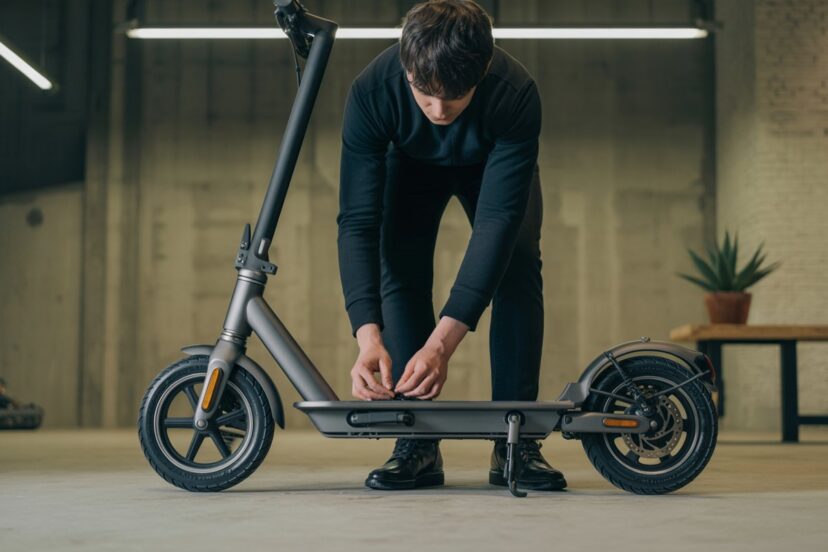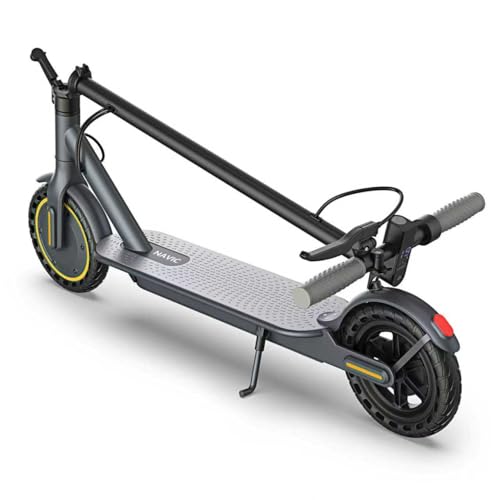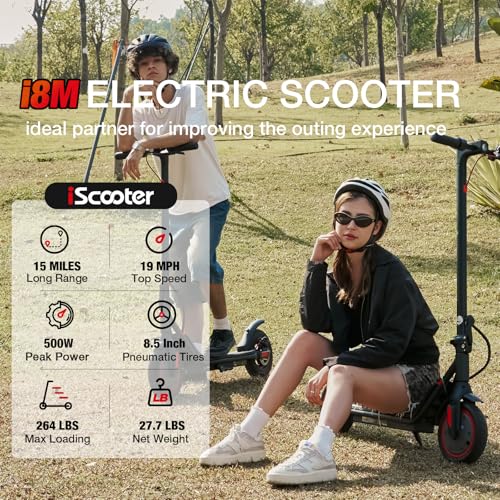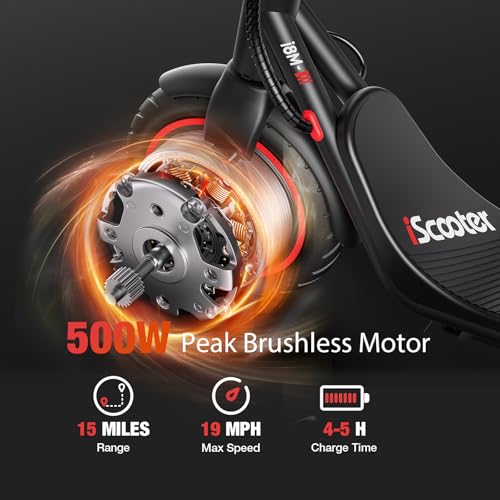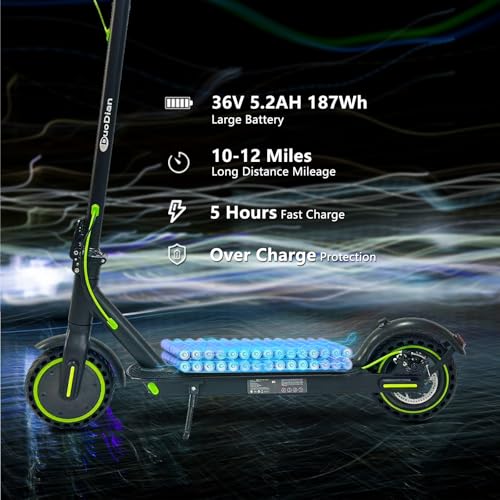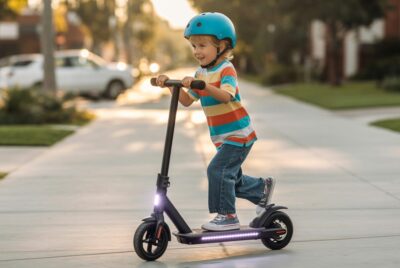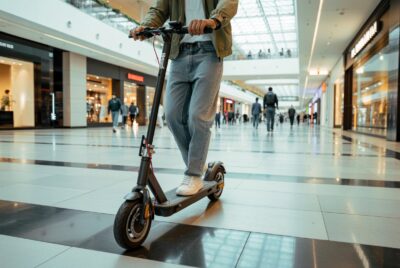How to Fold an Electric Scooter Without Damage
*We may earn a commission for purchases made using our links. Please see our disclosure to learn more.
The morning commute was about to begin when disaster struck. After months of carelessly folding an electric scooter without proper technique, the folding mechanism finally gave way with a sharp crack. What should have been a simple transition from riding to carrying became an expensive lesson in proper scooter care. This scenario plays out countless times as riders unknowingly damage their scooters through improper folding and carrying techniques.
Electric scooters have revolutionized urban mobility, offering a perfect blend of convenience and efficiency. However, their portability advantage disappears quickly when poor handling leads to costly repairs or complete device failure. Understanding the proper methods for folding and carrying these devices isn’t just about convenience—it’s about protecting a significant investment and ensuring reliable transportation for years to come.
“The key to electric scooter longevity isn’t just buying quality equipment—it’s developing the discipline to handle that equipment properly every single time you use it.”
— Urban Mobility Research Institute
Key Takeaways
- Proper preparation is essential: Always power down and clean your scooter before folding
- Follow manufacturer guidelines: Each scooter model has specific folding procedures that must be followed
- Use correct lifting techniques: Protect both your scooter and your body with proper carrying methods
- Regular maintenance prevents damage: Inspect folding mechanisms regularly and keep them clean
- Environmental awareness matters: Weather conditions and storage locations significantly impact scooter longevity
Recommended Electric Scooter Products
NAVIC T5 Electric Scooter
The NAVIC T5 Electric Scooter is designed for commuters who want performance, safety, and portability in one package. With a 350W motor (upgradeable to 500W), speeds of up to 22 mph, and a max range of 21–49 miles depending on the model, this scooter offers versatility for daily rides. Its dual-lock folding system makes it quick and secure to fold, ensuring you can carry and store it easily without damage. Equipped with a dual braking system, solid honeycomb tires, and app connectivity, the NAVIC T5 delivers smooth, reliable rides while staying ultra-portable for city living.
If you’ve ever wondered how to fold an electric scooter without damaging it, the NAVIC T5 makes the process simple and secure. Its dual-lock folding design ensures that the scooter stays stable while riding, yet folds quickly when you’re ready to carry it. At just 27.5 lbs, it’s lightweight enough for commuters who need to take it on public transport or store it under a desk. The scooter balances portability with power, offering speeds up to 22 mph and ranges up to 49 miles depending on the model. With solid honeycomb tires, dual braking, and app integration, the NAVIC T5 is built for safety and convenience, making it one of the best foldable electric scooters for adults in 2025.
- Performance: Powerful 350W motor with long-range options up to 49 miles.
- Portability: Dual-lock folding system makes it easy to fold and carry securely.
- Safety: Dual braking system with drum brake and EABS for better control.
- Weight: At 27.5 lbs, it may still feel heavy for some commuters to carry.
- Tire Type: Solid tires reduce maintenance but can feel less cushioned than pneumatic ones.
- Speed Variance: Performance can fluctuate based on terrain, weight, and battery level.
MAXSHOT Electric Scooter
The MAXSHOT Electric Scooter combines power, comfort, and convenience for both adults and teens. With a 500W motor, top speeds of up to 22 mph, and ranges between 12–49 miles depending on the model, it delivers reliable commuting performance. The dual suspension system and 10-inch honeycomb tires ensure smooth rides even on rough roads, while the dual braking system and UL 2272 certification provide added safety. Designed with portability in mind, this foldable e-scooter weighs just 36 lbs and folds down in seconds, making it easy to store in trunks, offices, or carry on public transportation.
If you’re learning how to fold an electric scooter, the MAXSHOT makes the process simple and secure. With a one-step folding mechanism, this e-scooter can be collapsed in seconds, reducing its size for easy storage in cars, offices, or public transport. At 36 lbs, it’s lightweight enough for commuting while still packing a 500W motor and a top speed of 22 mph. The scooter’s dual suspension system and honeycomb tires ensure smoother rides on rough surfaces, while dual braking and UL 2272 certification give riders extra safety. For anyone searching for a powerful yet portable e-scooter, the MAXSHOT is a top choice that balances durability, smart app control, and foldable convenience.
- Performance: 500W motor with multiple range options up to 49 miles.
- Comfort: Dual suspension and solid tires provide a stable ride on uneven terrain.
- Smart Features: LED display and app control for cruise control, lock, and ride stats.
- Weight: At 36 lbs, it’s heavier than ultra-light commuter scooters.
- Tire Type: Solid honeycomb tires trade comfort for low maintenance.
- Charge Time: Initial charge takes 6 hours, longer than some competitors.
iScooter Electric Scooter for Adults & Teens
The iScooter Electric Scooter for Adults & Teens combines speed, portability, and everyday convenience. With a 500W peak power motor, it reaches up to 25 mph and offers ranges from 15 to 25 miles depending on the model. Built with dual braking (electronic + disc) and UL2272-certified battery, it ensures safe commuting. The 3-second folding system makes it effortless to collapse and carry, weighing only 27.7 lbs for easy transport on public transit or storage in tight spaces. With pneumatic tires for comfort, LED display, app control, and included accessories, the iScooter is designed for commuting, campus rides, and eco-friendly travel.
Learning how to fold an electric scooter is simple with the iScooter i8M. Designed with a 3-second folding system, this e-scooter collapses quickly, making it easy to carry upstairs, store in a trunk, or take onto public transportation. At just 27.7 lbs, it strikes the perfect balance between portability and power, reaching speeds up to 25 mph with a max range of 25 miles. Equipped with pneumatic tires for smooth rides, dual braking for safety, and app integration for smart control, the iScooter is ideal for commuters and students alike. Whether you need a daily ride to work or a convenient way to get around campus, the iScooter offers a durable, foldable solution built for modern urban mobility.
- Performance: Powerful 500W motor with top speeds up to 25 mph.
- Portability: Lightweight 27.7 lbs design with 3-second folding mechanism.
- Safety: Dual braking, LED lights, and UL2272-certified battery for rider security.
- Range: 15–25 miles may not be enough for long-distance riders.
- Tire Type: Pneumatic tires provide comfort but require occasional maintenance.
- Price Tiers: Higher speed/range versions cost significantly more.
DUODIAN Electric Scooter for Adults
The DUODIAN Electric Scooter for Adults is built for convenience, portability, and reliable commuting. Powered by a 350W motor, it reaches speeds up to 19 mph and handles inclines of up to 15%. Its 8.5-inch honeycomb solid tires eliminate the need for maintenance, while the dual braking system ensures safety on busy streets. With a lightweight aluminum frame and foldable design, the scooter offers up to 12 miles of range per charge and folds down in seconds for easy carrying or storage. App connectivity adds extra control, letting riders lock/unlock, adjust speed, and enable cruise control right from a smartphone.
If you’re learning how to fold an electric scooter, the DUODIAN makes the process quick and effortless. Its lightweight aluminum frame and one-step folding design allow riders to collapse the scooter in seconds, making it easy to carry into the office, store in a trunk, or bring on public transport. Despite its portable build, the DUODIAN packs a 350W motor capable of speeds up to 19 mph and tackling mild uphill climbs. The 8.5-inch solid honeycomb tires ensure a puncture-free experience, while the dual braking system provides reliable stopping power. With app integration for cruise control, speed customization, and locking functions, the DUODIAN is a smart, foldable scooter designed for everyday commuters who need both performance and convenience.
- Motor Power: 350W motor delivers up to 19 mph and smooth uphill rides.
- Tire Durability: 8.5-inch solid tires are puncture-proof and maintenance-free.
- Portability: Lightweight, foldable frame ideal for commuting and storage.
- Range: 12 miles per charge may not suit long-distance commuters.
- Weight Limit: 220 lbs max load is lower compared to some competitors.
- Battery Life: Five-hour charging time is slower than fast-charge models.
Understanding Your Scooter’s Anatomy
Electric scooters represent sophisticated engineering packed into portable packages. The folding mechanism serves as the critical junction where convenience meets durability, and understanding its components makes the difference between years of reliable service and premature failure.
Most electric scooters employ either a lever-based or latch-based folding system. Lever systems use spring-loaded mechanisms that require specific pressure points to engage and disengage safely. Latch systems utilize hook-and-eye configurations that demand precise alignment during the folding process. Both systems share common vulnerabilities: they’re susceptible to dirt accumulation, wear from repeated use, and damage from excessive force.
The stem, handlebar assembly, and base platform form the primary structural elements that experience stress during folding. These components endure significant forces during both riding and folding operations, making proper technique essential for longevity. The battery compartment, typically located in the base platform, requires special attention during handling to prevent internal damage from drops or impacts.
Pre-Folding Preparation Rituals
Success in scooter maintenance begins before touching the folding mechanism. Developing consistent preparation habits prevents the majority of folding-related damage and extends overall device lifespan significantly.
Power management represents the first critical step. Always turn off the scooter completely before beginning the folding process. Many riders skip this step, but active electrical systems can experience phantom inputs during folding that may trigger unexpected responses or drain the battery unnecessarily. Allowing the scooter to cool down for several minutes after riding also prevents handling components while they’re hot from use.
Cleaning becomes particularly important for riders who encounter various weather conditions. Sand, salt, moisture, and debris accumulate in folding mechanisms and create abrasive conditions that accelerate wear. A quick wipe-down with a damp cloth removes surface contaminants, while compressed air clears debris from crevices and moving parts.
Weight distribution check ensures balanced handling during the folding process. Remove any accessories, bags, or additional weight from the handlebars or platform before folding. These items shift the scooter’s center of gravity and can cause unexpected movement during folding that leads to drops or impacts.
The Art of Proper Folding Technique
Mastering the folding sequence requires understanding that each step builds upon the previous one, creating a smooth transition from riding configuration to portable package. Rushing through this process or skipping steps invariably leads to problems.
Initial Positioning and Stance
Stand beside the scooter rather than behind it, maintaining a stable stance with feet shoulder-width apart. This position provides better leverage and control while reducing the risk of the scooter swinging into your body during folding. Keep one hand on the handlebar stem and locate the folding mechanism with the other hand before beginning any movement.
Engaging the Folding Mechanism
Different scooter models require specific techniques for engaging their folding systems. Lever-based systems typically require pulling up or pushing down on a spring-loaded lever while simultaneously applying gentle pressure to begin the folding motion. The key lies in smooth, deliberate movements rather than quick jerks that can damage internal components.
Latch-based systems demand careful alignment before attempting to disengage the locking mechanism. These systems often include safety features that prevent accidental folding during use, requiring specific sequences of movements to unlock. Never force a latch system—if it doesn’t release easily, check for proper positioning and ensure you’re following the correct sequence.
Managing the Folding Motion
As the folding mechanism engages, guide the handlebar stem down toward the base platform in a controlled manner. Gravity assists this process, but uncontrolled folding can cause the stem to slam into the platform with enough force to damage both components. Use your supporting hand to moderate the speed and ensure the stem settles gently into its folded position.
Pay attention to cable management during folding. Electric scooters contain various cables connecting the handlebar controls to the motor and battery systems. These cables should move freely during folding without binding, pinching, or stretching excessively. If you notice cable resistance, stop the folding process and investigate before continuing.
Securing the Folded Configuration
Most scooters include mechanisms to secure the folded configuration, preventing accidental unfolding during transport. These might be hooks, straps, magnetic catches, or secondary latches. Engaging these security features prevents the scooter from unfolding unexpectedly, which can cause injury or damage.
Carrying Techniques That Protect
Once folded, the scooter transforms from a riding device into a piece of luggage that requires appropriate handling techniques. Poor carrying methods cause more damage than improper folding, as they subject the scooter to repeated stresses over extended periods.
Weight Distribution and Grip Points
Electric scooters typically weigh between 25-40 pounds, with weight concentrated in the battery compartment located in the base platform. This weight distribution creates an unbalanced load that can strain joints and muscles if handled incorrectly. Identify the optimal grip points on your specific model—usually the stem near the folding mechanism and a designated handle or strong point on the base platform.
Avoid gripping plastic components, cables, or accessories when lifting. These elements aren’t designed to support the scooter’s full weight and can break or become damaged under load. Many scooters include dedicated carrying handles or reinforced grip areas specifically designed for transport.
Lifting and Movement Techniques
Use proper body mechanics when lifting your folded scooter. Squat down to grip level, engage your core muscles, and lift with your legs rather than your back. Keep the scooter close to your body during transport to reduce strain and improve control. For extended carrying periods, alternate between different grip positions to prevent fatigue and repetitive strain.
When navigating stairs, elevators, or tight spaces, plan your route in advance to minimize the time spent carrying the scooter. Scout locations for temporary resting spots where you can safely set down the scooter if needed. Trying to power through long carries when fatigued increases the risk of drops and impacts.
Transport Considerations
Different transport scenarios require adapted techniques. Public transportation often involves crowded conditions where the scooter must be held securely while managing other passengers and obstacles. Position the scooter to minimize its profile and avoid contact with other passengers or surfaces that might cause scratches or damage.
Vehicle transport requires securing the scooter to prevent movement during acceleration, braking, and turns. Use soft padding or blankets to prevent contact between the scooter and hard surfaces in the vehicle. Avoid placing heavy objects on top of the folded scooter, as this can damage sensitive components or compromise the folding mechanism.
Storage Best Practices
Proper storage extends beyond simply finding a place to put your folded scooter. Environmental factors, positioning, and preparation significantly impact long-term durability and performance.
Environmental Control
Temperature extremes affect both mechanical and electrical components. Store scooters in climate-controlled environments when possible, avoiding areas subject to freezing temperatures or excessive heat. Garages, basements, and storage sheds often experience temperature fluctuations that can damage batteries and cause condensation in electrical components.
Humidity control prevents corrosion and electrical problems. High humidity environments promote rust formation on metal components and can cause electrical connections to corrode. Use desiccants or dehumidifiers in storage areas prone to moisture problems, and consider protective covers for long-term storage.
Positioning and Support
Store folded scooters in upright positions when possible, as this reduces stress on the folding mechanism and prevents flat spots from developing on tires. If horizontal storage is necessary, use padding to support the scooter evenly and prevent pressure points that can cause deformation over time.
Avoid leaning scooters against walls or other objects in ways that create pressure on the folding mechanism or handlebars. These contact points can develop permanent deformation or damage over time, especially in temperature-varying environments where materials expand and contract.
Maintenance and Inspection Routines
Regular maintenance prevents small problems from becoming major failures. Developing consistent inspection and care routines keeps folding mechanisms operating smoothly and identifies potential issues before they cause damage.
Folding Mechanism Care
Clean folding mechanisms monthly using compressed air to remove debris and accumulated dust. Apply appropriate lubricants to moving parts according to manufacturer specifications—typically light machine oil or specialized bearing grease. Avoid over-lubrication, which attracts dirt and can interfere with proper mechanism operation.
Inspect wear points regularly for signs of excessive wear, cracking, or deformation. Pay particular attention to pivot points, springs, and locking surfaces where repeated stress can cause fatigue failures. Replace worn components promptly to prevent cascading damage to other system elements.
Preventive Measures
Document your scooter’s condition with regular photos, particularly of the folding mechanism and any wear points. This documentation helps track deterioration over time and provides valuable information for warranty claims or repair decisions.
Maintain spare parts inventory for commonly worn components like springs, screws, and rubber seals. Having replacement parts available prevents extended downtime when maintenance becomes necessary and ensures you can address problems immediately rather than continuing to use damaged components.
Troubleshooting Common Issues
Even with proper technique, folding mechanisms occasionally develop problems that require attention. Understanding common issues and their solutions prevents minor problems from becoming major repairs.
Stiff or Resistant Folding Action
When folding mechanisms become difficult to operate, the problem usually stems from debris accumulation, lack of lubrication, or component wear. Begin troubleshooting by cleaning the mechanism thoroughly and applying appropriate lubricants to moving parts. If stiffness persists, inspect for bent or damaged components that might interfere with smooth operation.
Temperature can affect folding mechanism operation, particularly in cold weather when lubricants thicken and metal components contract. Allow scooters to acclimate to room temperature before folding in extreme weather conditions.
Loose or Wobbly Folded Configuration
Looseness in the folded position usually indicates wear in the folding mechanism or improper engagement of locking systems. Check that all latches, hooks, or securing devices are properly engaged and functioning correctly. Inspect pivot points for excessive wear that might allow unwanted movement.
Some looseness can be adjusted through mechanism tensioning or component replacement. Consult manufacturer documentation for specific adjustment procedures, as improper adjustments can create safety hazards during riding.
Unusual Noises or Grinding Sensations
Grinding, clicking, or scraping sounds during folding indicate mechanical problems that require immediate attention. These symptoms often signal debris in the mechanism, worn components, or insufficient lubrication. Stop using the folding mechanism until the source of the noise is identified and corrected.
Metal-on-metal contact can cause rapid wear and permanent damage if not addressed promptly. Clean and inspect the mechanism thoroughly, replacing any visibly worn or damaged components before resuming normal use.
Advanced Protection Strategies
Beyond basic folding and carrying techniques, advanced strategies provide additional protection for riders who depend heavily on their scooters or operate in challenging environments.
Environmental Adaptation
Riders in coastal areas face salt air corrosion that accelerates mechanism wear and electrical system degradation. Increase cleaning frequency and consider protective coatings or covers to minimize salt exposure. Rinse folding mechanisms with fresh water after exposure to salt air, and dry thoroughly before storage.
Urban environments present unique challenges including dust, pollution, and frequent temperature cycling. Develop cleaning routines that address these specific environmental factors, and consider more frequent maintenance intervals to compensate for accelerated wear conditions.
Usage Pattern Optimization
Heavy daily users benefit from rotating between multiple scooters to reduce wear on any single device. This strategy distributes mechanical stress across multiple units and provides backup transportation when one scooter requires maintenance or repair.
For occasional users, proper preparation becomes even more critical since extended storage periods can cause mechanisms to become stiff or accumulate debris. Establish pre-use inspection routines that verify proper folding mechanism operation before each ride.
Building Long-Term Success Habits
Sustainable scooter care requires developing habits that become automatic rather than conscious decisions. Successful riders integrate proper techniques into their daily routines until correct handling becomes instinctive.
Routine Development
Create consistent pre-folding and post-folding checklists that ensure all necessary steps are completed every time. Post these checklists in storage areas or keep them accessible on mobile devices until the routines become habitual. Consistency prevents the gradual degradation of technique that occurs when riders become complacent.
Track maintenance activities and mechanism performance over time to identify patterns and optimize care routines. Document any problems or unusual wear to help identify environmental factors or usage patterns that might require adjustment.
Community and Knowledge Sharing
Connect with other electric scooter users to share experiences and learn from different perspectives on care and maintenance. Online communities often provide valuable insights into model-specific issues and solutions that aren’t covered in manufacturer documentation.
Stay informed about manufacturer updates, recalls, or service bulletins that might affect your specific scooter model. Register your scooter for warranty coverage and maintain communication with authorized service providers for complex issues beyond basic maintenance.
Conclusion
Protecting your electric scooter through proper folding and carrying techniques represents a small investment of time and attention that pays enormous dividends in device longevity and reliability. The habits developed through consistent application of these methods extend far beyond preventing mechanical damage—they create a mindset of care and attention that improves every aspect of scooter ownership.
The transition from careless handling to deliberate technique might seem overwhelming initially, but like any skill, it becomes natural with practice. Each successful folding operation, each careful carry, and each thorough cleaning session builds toward years of reliable transportation and reduced maintenance costs.
Remember that your electric scooter represents more than just a transportation device—it’s a gateway to freedom, efficiency, and environmental responsibility. Treating it with the respect and care it deserves ensures that gateway remains open for years to come, providing countless journeys with confidence and peace of mind.
Frequently Asked Questions
Q: How often should I clean my scooter’s folding mechanism?
A: Clean the folding mechanism at least once a month during regular use, or more frequently if you ride in dusty, sandy, or wet conditions. After riding in rain or through puddles, clean and dry the mechanism immediately to prevent corrosion and debris buildup.
Q: What should I do if my scooter won’t fold properly after working fine for months?
A: First, check for debris or dirt in the folding mechanism and clean thoroughly. Apply appropriate lubricant to moving parts and inspect for visible wear or damage. If problems persist, consult your owner’s manual or contact the manufacturer, as internal components may need replacement.
Q: Is it safe to carry my electric scooter by the handlebars when folded?
A: Generally no—handlebars aren’t designed to support the full weight of the scooter and can be damaged by carrying loads. Use designated carrying handles or grip the stem near the folding mechanism along with a secure point on the base platform for balanced lifting.
Q: Can I leave my scooter folded for extended periods, or should I unfold it regularly?
A: Extended folding is generally acceptable, but unfold your scooter periodically (every few weeks) to exercise the mechanism and prevent components from becoming stiff. This also allows you to inspect for any issues that might develop during storage.
Q: What’s the best way to transport a folded scooter in bad weather?
A: Use a protective cover or bag designed for your scooter model to shield it from rain, snow, and road salt. If no cover is available, wrap the scooter in a plastic bag or tarp, paying special attention to protecting electrical components and the folding mechanism from moisture.

